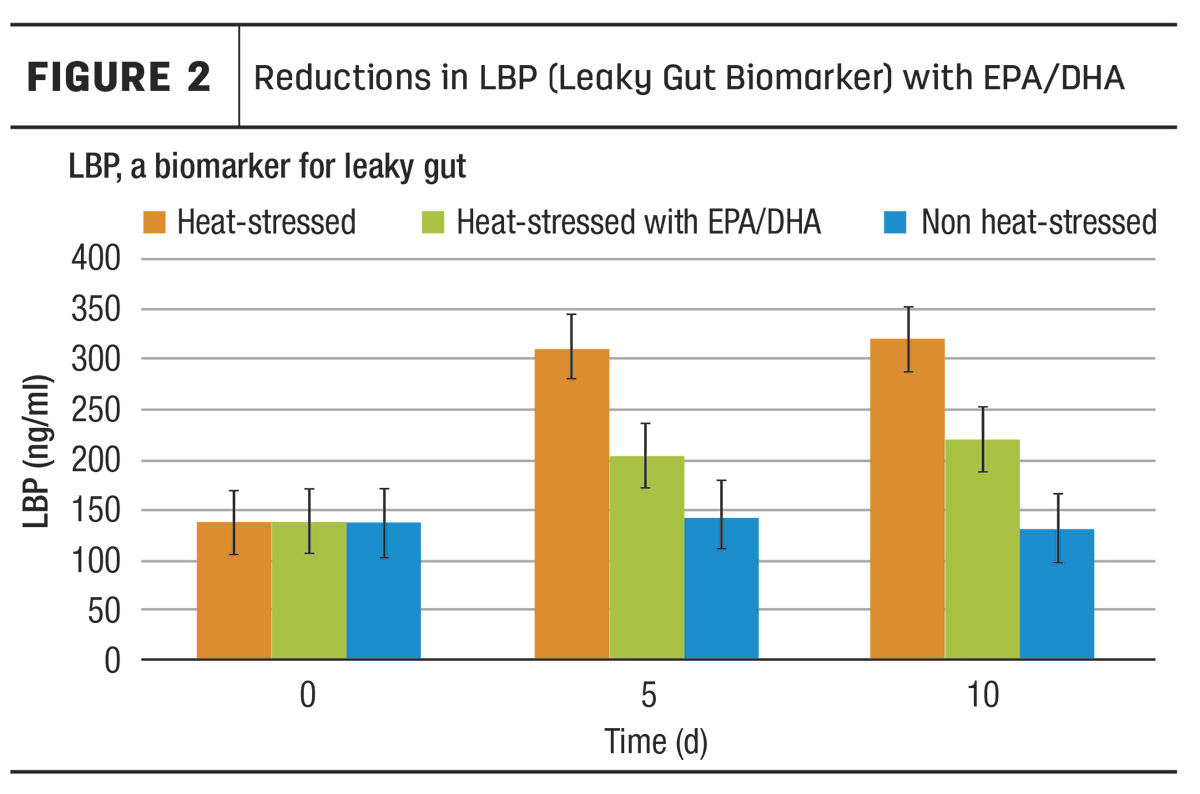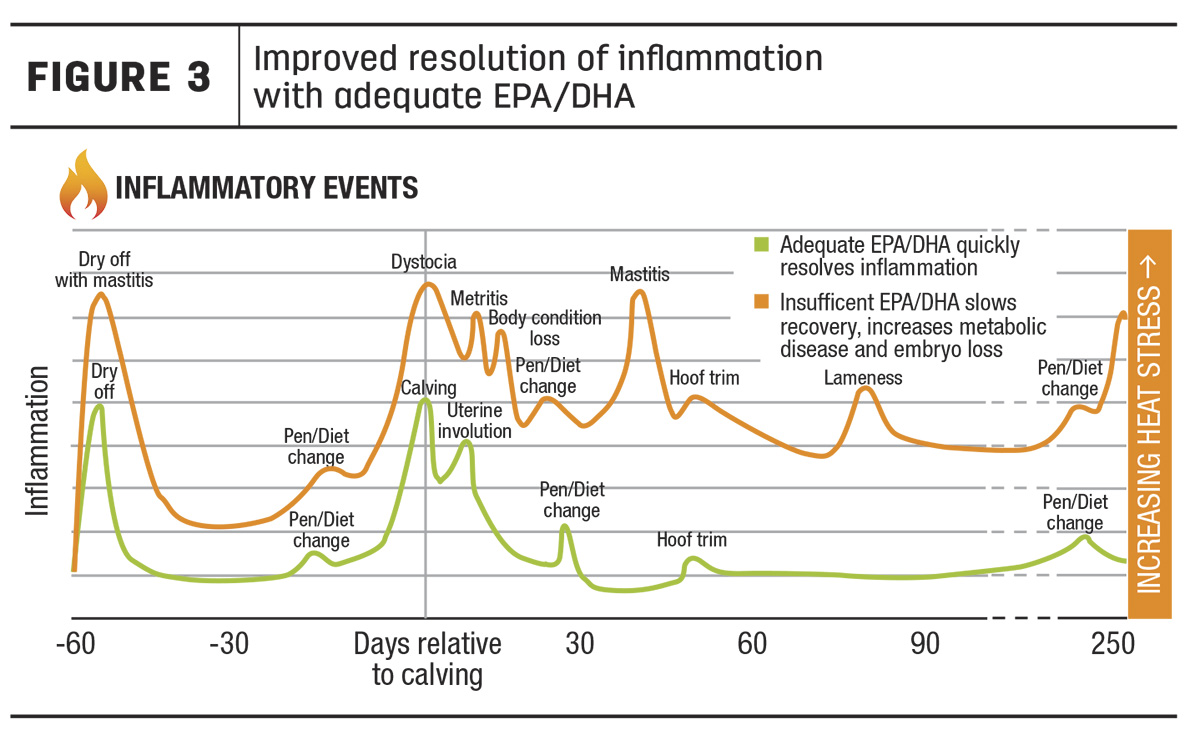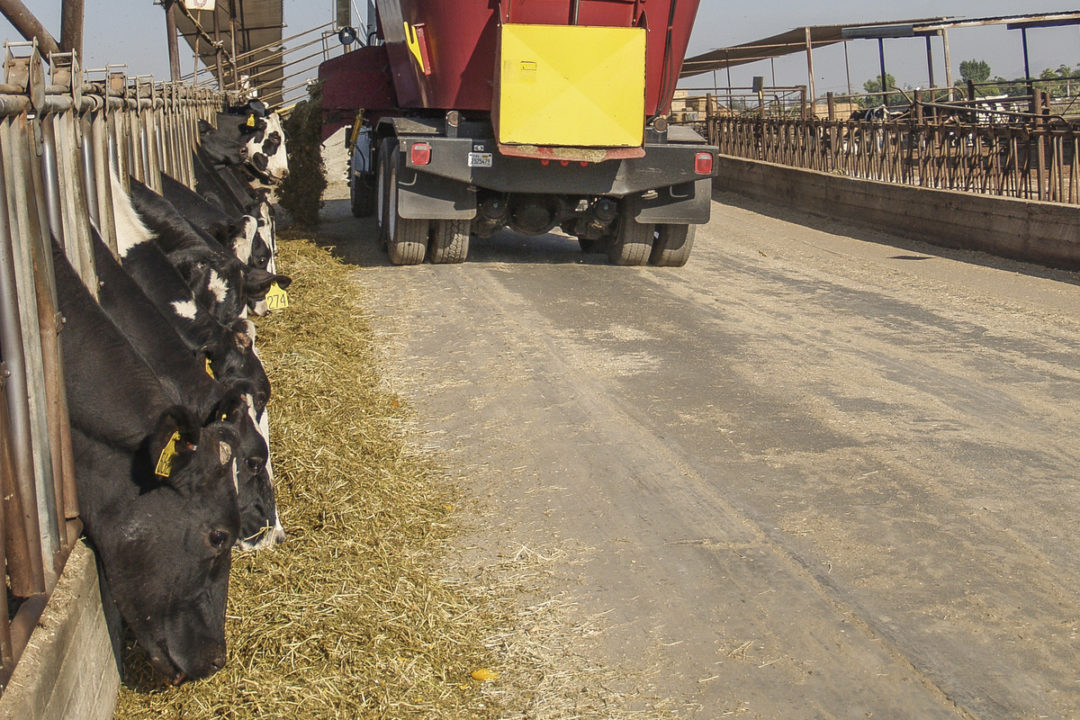Robust. That’s an accurate word to describe the research to support cow cooling investments to reduce heat stress effects. The financial consequences of heat stress on dairy farms in the U.S. are massive, with estimates between $897 million to $1.5 billion. And if we needed more convincing, the research done by Dr. Geoffrey Dahl at the University of Florida shows we not only lose 10 pounds of milk over the lactation when dry cows are not cooled, but we lose another 10 pounds in their offspring due to in-utero heat stress effects. Therefore, we install the fans, we add the sprinklers, we redesign holding pens for better air and traffic flow, we even extend these “luxuries” to our dry cows when possible. The cows then eat more, and the investments almost always pay.
While mitigating heat stress with proper cow cooling lays the foundation, recent research shows that properly supplying essential nutrients to dairy cows, specifically EPA/DHA omega-3s, may be just as important in tempering inflammation and helping cows be more resilient through immune challenges.
The study set-up
There are two main reasons why cows lose production during heat stress: lower dry matter intakes (DMI) and heat stress-triggered inflammation. Dr. Daniel Rico and his team at CRSAD in Quebec have been on a mission to tease out the latter by using a robust "pair-feeding" model, testing an array of different nutrients to identify nutritional strategies that may alleviate heat stress effects. In this study set-up, the non-heat-stressed group is provided the same DMI as the heat-stressed group. Therefore, any differences in physiological measurements and performance are strictly attributed to the reductions in inflammation.
In their most recent study, they set out to determine if EPA/DHA would reduce the heat stress-associated immune response and lead to greater milk yield. There were three treatments: a thermal-neutral control group (pair-fed same DMI as heat-stressed cows), heat-stressed cows and heat-stressed cows with EPA/DHA. In this first study, the researchers abomasally infused EPA/DHA to deliver to the lower gut for absorption.
Improvements in milk, rectal temp and respiration rates
Results in this experiment demonstrated that EPA/DHA has the clear ability to reduce and resolve inflammation from heat stress, resulting in a 4.4-pound higher milk yield compared to the heat-stressed cows that were lacking in EPA/DHA (Figure 1). What is just as striking are the impacts on the cows' base physiology, as measured by lowered rectal temperatures and respiration rates. Rectal temperatures responded quickly to EPA/DHA, with a lower trend within two days of EPA/DHA being introduced versus the heat-stressed cows without EPA/DHA. Respiration rates followed a similar response, with an average of 20 beats per minute less from day two through day 10 in the heat-stressed cows receiving EPA/DHA versus the heat-stressed cows without EPA/DHA.

The next question you may likely be asking is “Why?” While EPA/DHA is known for its anti-inflammatory effects, what is the mechanism for seeing these heat stress symptoms alleviated so quickly and resulting improvements in milk yield? Were the results simply due to less inflammation, or is there more to it? Previous studies have demonstrated a clear connection between heat stress causing increased intestinal permeability (leaky gut). In short, the cow’s gut lining is just one cell thick, which under healthy circumstances allows for proper absorption of nutrients and water exchange. However, under stress conditions the "tight junctions" between the cells can become compromised, allowing for pathogens to flow out of the gut and into the bloodstream. These pathogens then trigger immune activation and a whole cascade of inflammatory responses that hinder health and productivity. There are specific nutrients that are important for maintaining gut integrity, with EPA/DHA being one of those nutrients.
In this study, LBP (lipopolysaccharide binding protein) was measured as biomarker of leaky gut; higher LBP means more inflammation. LBP went up dramatically in the heat-stressed cows versus the thermal neutral cows, as expected. In contrast, LBP was reduced by half in the heat-stressed plus EPA/DHA cows, confirming the influence of EPA/DHA on reducing immune activation (Figure 2).

The immune system and metabolism are also tightly linked. Cows with heat stress have higher levels of insulin released from the pancreas, which funnels more glucose to the immune cells to mount a defense against infection. The result is less glucose available to the mammary gland for production. In this study, insulin spiked as expected with the heat-stressed cows but was greatly tempered by the effects of EPA/DHA. Meanwhile, the increase in NEFAs (body fat mobilization) was also reduced compared to the heat-stressed cows without EPA/DHA.
All stressors have one thing in common: Inflammation
Heat stress is a pertinent example of a seasonal stress that dairy cattle often encounter. However, this stressor adds a significant layer of stress on top of all the other stressors that happen over their lactation (Figure 3). From dry-off to calving, uterine involution, metritis, social stress and diet changes, inflammation is triggered to one degree or another on a daily and weekly basis.

Each of these stressors triggers inflammation, which then lights a fire under the immune cells to spring them into action. All the immune system’s “excessive activities” cost dollars (in the form of glucose being directed away from the mammary gland). How costly is this immune activation? If we use this heat stress study as an example, 4.4 pounds of milk were "recaptured" by EPA/DHA’s sparing of glucose from the immune system. The net energy of lactation (NeL) equivalent is 1.66 pounds of corn grain, .57 pound of fat or 1.92 pounds of DMI (may vary based on NeL of diet). No doubt, the immune system is demanding, often expensive and deserves its own management plan.
Management and nutrition: Both matter
An effective strategy for reducing the effects of inflammation should include both management and nutrition. Good husbandry practices that keep cows comfortable, reduce exposure to pathogens and minimize social stress are important and a front-line defense against inflammation. At the same time, the nutrients we feed our cows set the foundation for how her immune system will respond to these stressors, whether it be a healthy and appropriate immune response or an exaggerated response that lingers and becomes chronic. While most items on this checklist (Figure 4) indirectly reduce inflammation by reducing stress, EPA/DHA is unique, as it directly acts on existing inflammation, preventing an exaggerated immune response (minimizes the spike) and actively resolving inflammation so she can more quickly return to productivity.

As you’re challenged this year by high feed costs and lower milk prices, review your management and nutrition practices through the lens of reducing inflammation. No doubt there’s an opportunity or two to recapture some of what inflammation has stolen, such as more glucose for the mammary gland, better health for your cows and hidden margin when you need it most.












